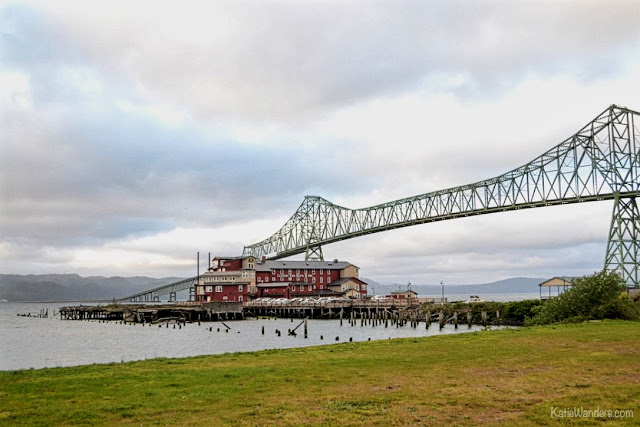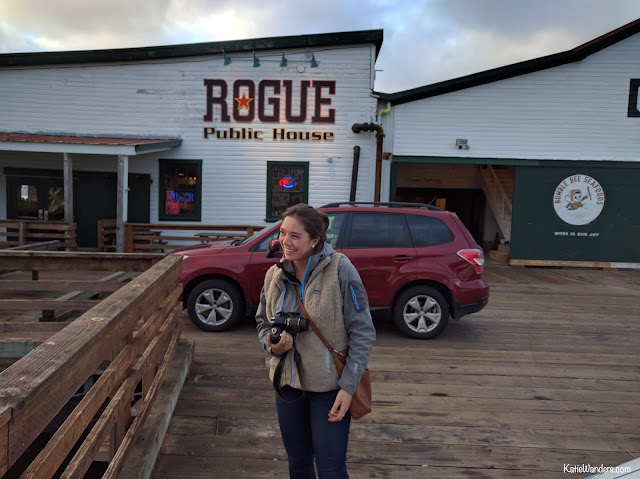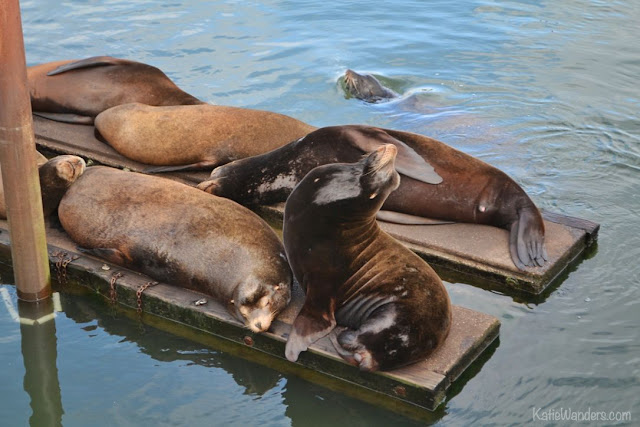 |
Astoria is a quiet coastal town at the mouth of the 1,200 mile Columbia River with a whole lot of character. At first glance, the town has a charm to it, but was generally a little run down, a foggy memory of its historic past. This town is home to famous movies like the Goonies and Kindergarten Cop, with a thick history dating back to Lewis and Clark. And then there is the unpopular seasonal visitor, the California Sea Lion.

Astoria is a town rich in history and really has that "outdated fishing town" appearance (a theme for the Oregon coast we would soon learn). What remains is a real sense of Pacific charm between some old coastline and Victorian Houses. Astoria is the oldest American settlement west of the rockies. In 1805, Lewis and Clark led their expedition just south of Astoria. Fort Clatsop National Memorial commemorates the western end of the Lewis & Clark Trail. John Jacob Astor's men who set up the town in 1811 for their fur trading post (and the primary fur trading post in the northwest and important post for American exploration).
The town was eventually taken by the British and was restored to the U.S. in 1818, though the fur trade would remain under British control until American pioneers following the Oregon Trail began filtering into the port town in the mid-1840s. The Treaty of 1818 established joint U.S. - British occupancy of territory west of the continental divide to the Pacific Ocean. In 1846 the Oregon Treaty ended the Oregon Boundary Dispute; with Britain ceding all right to the mainland south of the 49th Parallel. Source

 |
| The 4.21 mile long Astoria-Megler Bridge is the longest continuous truss span bridge in the world. |
The current Astoria has many relics of its past. While stopping in Astoria to spend the night before continuing our trip down the coast, we stayed at the Motel 6 in Astoria (dog friendly and nice rooms for a good price). We were located right under the bridge in front of Maritime Memorial Park, dedicated to the memories of local people who were involved in the maritime industry and members of the U.S. Coast Guard who lost their lives while serving on the Columbia River. The view of the bridge and the water can make any land locked girl happy to be spending the night in this historic little town.
 |
| View from our room. |
We were also right outside the walking path following the town trolly's tracks. Astoria's trolly takes tourists to various stops along the shoreline. Astoria originally had trolley service back in the 1880s (at first horse-drawn, then electric). Now the trolly is used as a sight seeing tour in the summer as a quick way to get between Astoria's destinations.
 |
| Salmon signs and trolly stops around Astoria |
You will see the iconic salmon, and hints of Astoria's industrial path all over town. Industry in the area shifted from fur trade, to the canning trade, canning chinook salmon until the fishery collapsed in the 1940's, turning canning operations from salmon to albacore tuna. In 1976 the cannery (by then known as Bumble Bee Seafoods) had ceased to can salmon and dealt strictly with tuna production until 1980 when it was closed down completely. Source.
 |
| Beer sampler at Rogue Brewery, Astoria |
 |
| Rogue Brewery, Astoria |
We decided to stop into Rogue Brewery to sample some beers and watch the sunset, The brewery is set up on stilts over the water, with even the driveway and parking area up on stilts. It was that walk into the brewery when I heard the familiar sounds of barking sea lions a few docks away.

The California Sea Lion calls a few docks in the East Mooring Basin a temporary home. While the females are raising their pups, the males migrate to Oregon to eat fish and fight over the docks.
The sea lions (all males, an estimated 2,400, a surprising 1,000 more than last year) are claimed to cost the port $100,000 a year between loss of rented slips, damage to the docks, 24 hour barking and noise, and consumption of salmon. There have been many attempts to get the sea lions off Astoria's docks, from Fake Willy, (a life-size orca whale replica that took on water and never worked), chicken wire, beach balls and electrified mats. New strategies include a "guard rail" around the docks and one of those crazy dancing air streamer icons that you find outside car shops.
Biologists have suggested the animals eat about one in 25 returning spring chinook salmon at the base of the dam. In 2011 and ’12, more than 80 percent of the fish reached the dam; but in 2014, only 55 percent got that far. Nearly half the run, in other words, disappeared somewhere in the lower Columbia. Source
Biologists have suggested the animals eat about one in 25 returning spring chinook salmon at the base of the dam. In 2011 and ’12, more than 80 percent of the fish reached the dam; but in 2014, only 55 percent got that far. Nearly half the run, in other words, disappeared somewhere in the lower Columbia. Source
 |
| Pier leading to the California Sea Lions of Astoria |
 |
| Sea Lions of Astoria |
The issue of Astoria is the battle between the federally protected marine mammal clashing with the endangered salmon. Who gets to stay? Federal workers contain, tag, measure and brand these sea lions for scientific and tracking purposes. There are various methods of keeping the sea lions away from the Bonneville Dam (and the salmon) such as "seal bombs".
Back in 2008, Oregon and Washington received permission from NOAA to trap and euthanize sea lions that continued eating fish at the dam. These days, the states are authorized to “remove” up to 92 repeat offenders annually. Since 2008, the states have euthanized 85 California sea lions (including 30 in 2015) and sent another 15 off to captivity. Seven more California sea lions, and one Stellar sea lion, died accidentally in traps. (Stellars, which are endangered, aren’t targeted for killing.)". Source
 |
| Enclosure where sea lions are contained, measured, tagged and branded. |
According to local activist groups "Per the letters of authorization from the federal government to the states of Oregon, Washington and Idaho, California sea lions who meet the following criteria are subject to lethal removal from the dam:
1. Have been observed eating salmonids at Bonneville Dam, in the "observation area" below the dam, in the fish ladders, or above the dam, between January 1 and May 31 of any year;
2, Have been observed at Bonneville Dam on a total of any 5 days (consecutive days, days within a single season, or days over multiple years) between January 1 and May 31 of any year; and
3. Are sighted at Bonneville Dam after they have been subjected to active non lethal deterrence.
The sea lions may be killed by lethal injection or shot by high powered rifle. Their bodies are to be disposed of in accordance with applicable law". Source
 |
| Sea Lions of Astoria |
Despite what side you stand on in the "Sea Lion vs Salmon" issue, being able to visit these sea lions in Astoria was a major plus for me. Watching them up close (and in the wild!) interacting with the other males was something I could have spent a few days doing, well if it wasn't for all the noise they make.
A cute town full of sea lions, history and charm, and the perfect first starting place for our our trip down the Oregon Coast.
Other Oregon Coast Posts:

No comments :
Post a Comment
Let's Chat!